Multi-Locomotion Design and Implementation of Transverse Ledge Brachiation Robot Inspired by Sport Climbing
Abstract
:1. Introduction
2. Locomotion for Transverse Ledge Brachiation
2.1. Transverse Ledge Brachiation Based on Athletes’ Locomotion
2.2. Transverse Ledge Ricochetal Brachiation Based on Athletes’ Locomotion
2.3. Problem Statement
3. System Modeling
- Swinging phase
- 2.
- Approaching-target phase
- 3.
- Transition phase
- 4.
- Hands-on phase
- 5.
- Two-hand-release phase
4. Robot Locomotion Design
4.1. Locomotion for Transverse Brachiation
- (1)
- each movement phase must be executed successfully, and two continuous locomotion gait cycles must be completed; in other words, eight movement phases must be completed continuously;
- (2)
- the energy connecting the motion processes of each phase must be maintained and not return to zero at the end of which phase, which would cause uncoordinated motions.
4.1.1. Design Requirements and Analysis Procedure for Transverse Brachiation
4.1.2. Motion Control Strategy Associated with Approaching-Target Phase for Transverse Brachiation
4.1.3. Motion Control Strategy Associated with Swinging Phase for Transverse Brachiation
4.1.4. Motion Control Strategy Associated with Transition Phase for Transverse Brachiation
4.1.5. Motion Control Strategy Associated with Hands-on Phase for Transverse Brachiation
- Swinging phase→Approaching-target phase: arm swing angle becomes ;
- Approaching-target phase→Transition phase: vertical position of grasping gripper coincides with ledge position ;
- Transition phase→Hands-on phase: tail link swings back until joint angle ;
- Hands-on phase→Swing phase: vertical position of returning gripper coincides with the ledge position .
4.2. Locomotion for Transverse Ricochetal Brachiation
- The first step in the two-hand-release phase of TLRB is realizing the leap. However, as the left gripper releases the ledge in the instant before the right gripper reaches the ledge, we can assume that the arms begin to resume their original position once the right gripper has grasped the ledge. Based on the joint trajectory planning represented by Equation (11) for the TLB gait, the upper limbs almost form a parallelogram once the left arm resumes its original position. This can be referred to as the locomotion cycle of a TLRB gait.
- As the execution of the flight stage is short, the various joint angle commands of the robot remain the same as they were at the end of the previous phase (i.e., the joint angles at the instant the left gripper releases the ledge).
- We adopted the same parameter settings as those of the TLB gait for the initial robot posture, excitation frequency, and amplitude in tail joint trajectory planning.
- Unlike the TLB gait, where the need for a posture adjustment phase causes the grasping distance to be restricted by mechanical flexibility, this gait mainly uses the energy accumulated in the swinging phase to lengthen the grasping distance as much as possible. The analysis results in Figure 9 show that as the TLRB gait does not require the posture adjustment phase, the constraint can be removed from Equation (8). In this way, the grasping distance in the approaching-target phase is no longer restricted by mechanical flexibility. In other words, when the angle of the left arm in the swinging phase is , the right gripper can release the ledge, and the inertia of the robot can be effectively utilized to achieve the maximum grasping distance . Thus, we chose as the design condition for switching from the swinging phase to the approaching-target phase. Note that these are only the results derived based on the analysis of the dynamic models in the first two phases of the TLB gait. Later, the energy accumulated in previous phases can be further used to increase the total grasping distance during the leap.
- As shown in Figure 13c, the robot switches to the hands-on phase once its fore (right) gripper grasps the ledge in the two-hand-release phase. The switching condition can be expressed using the following equation:where are the y coordinates of the left and right gripper joints in the two-hand-release phase.
- As shown in Figure 13d, the hands-on phase mainly utilizes the horizontal inertia the robot obtained to leap. After the right gripper grasps the ledge, the left arm joint uses Equation (11) to bring the left gripper forward to grasp the ledge, thereby completing a TLRB locomotion cycle. At this point, the upper limbs of the robot again for a parallel four-bar linkage and the y coordinate of the left gripper joint can also serve as the basis of judgment for the swing phase in the next locomotion cycle.
- Figure 13a,b exhibit the schematics of the TLRB gait in the target-approaching phase. The focus of this movement phase is the timing of when the left gripper releases the ledge to perform the leap motion after the right gripper reaches out for a good grasping distance (). Here, we used the right arm joint angle () as the basis for phase switching, as shown in Figure 13c. Note that the here is based on the ideal grasping distance derived from the dynamic analyses of the approaching-target phase and the flight phase and is different from the results obtained from the analysis in the previous section, which did not consider flight dynamics. Based on the above assumptions, we conducted a dynamic simulation of the entire gait using the switching conditions of the previous phases. As can be seen in Figure 14, there is a greater increase in the amount of time that the right gripper is airborne after the left gripper releases the ledge, and this increases the landing success rate. However, the grasping distance also decreases as the height of the right arm increases. Considering the mechanical restrictions of the body and arm links in the robot hardware, we chose to have the robot’s left gripper release the ledge for the leap motion when the right arm raises to in the approaching-target phase. The resulting grasping distance is approximately 130 mm. Note that only when the robot is not airborne in the instant the right gripper releases the ledge is phase-switching considered successful. Simulations with this condition parameter revealed that the distance between the two grippers in the hands-on phase is around 127 mm. To move closer to the upper limb ledge grip posture of parallel four-bar linkage, a smaller reference value can be used as the phase-switching condition. However, this may also cause the flight duration of the right arm to be too short and result in gait failure during mechatronic system realization.
- Swinging phase→Approaching-target phase: arm swing angle becomes ;
- Approaching-target phase→Two-hand-release phase: robot releases the ledge-holding (left) hand when the joint angle of the approaching (right) arm reaches ;
- Two-hand-release phase→Hands-on phase: vertical position of approaching hand coincides with ledge position ;
- Hands-on phase→End: vertical position of returning hand coincides with the ledge position .
5. Experiments and Discussion
5.1. Experiment Setup
5.2. Experiments for Transverse Brachiation
5.2.1. Single Locomotion Cycle
5.2.2. Continuous Transverse Brachiation
5.3. Experiments for Transverse Ricochetal Brachiation
6. Conclusions
Author Contributions
Funding
Data Availability Statement
Conflicts of Interest
References
- Lin, C.-Y.; Yang, Z.H. TRBR: Flight body posture compensation for transverse ricochetal brachiation robot. Mechatronics 2020, 65, 102307. [Google Scholar] [CrossRef]
- Lin, C.-Y.; Tian, Y.-J. Design of Transverse Brachiation Robot and Motion Control System for Locomotion between Ledges at Different Elevations. Sensors 2022, 22, 4031. [Google Scholar] [CrossRef] [PubMed]
- Official Website of the International Federation of Sport Climbing. Available online: https://www.ifsc-climbing.org/ (accessed on 22 March 2023).
- Wang, S.; Jiang, H.; Myung Huh, T.; Sun, D.; Ruotolo, W.; Miller, M.; Roderick, W.R.T.; Stuart, H.S.; Cutkosky, M.R. Spinyhand: Contact load sharing for a human-scale climbing robot. J. Mech. Robot. 2019, 11, 031009. [Google Scholar] [CrossRef]
- Wei, D.; Ge, W. Research on one bio-inspired jumping locomotion robot for search and rescue. Int. J. Adv. Robot. Syst. 2014, 11, 168. [Google Scholar] [CrossRef]
- Patané, L. Bio-inspired robotic solutions for landslide monitoring. Energies 2019, 12, 1256. [Google Scholar] [CrossRef]
- Seo, T.; Jeon, Y.; Park, C.; Kim, J. Survey on glass and façade-cleaning robots: Climbing mechanisms, cleaning methods, and applications. Int. J. Precis. Eng. Manuf. 2019, 6, 367–376. [Google Scholar] [CrossRef]
- Schultz, J.T.; Beck, H.K.; Haagensen, T.; Proost, T.; Clemente, C.J. Using a biologically mimicking climbing robot to explore the performance landscape of climbing in lizards. Proc. R. Soc. B 2021, 288, 20202576. [Google Scholar] [CrossRef] [PubMed]
- Zheng, Z.; Ding, N.; Chen, H.; Hu, X.; Zhu, Z.; Fu, X.; Zhang, W.; Zhang, L.; Hazken, S.; Wang, Z.; et al. CCRobot-V: A silkworm-like cooperative cable-climbing robotic system for cable inspection and maintenance. In Proceedings of the International Conference on Robotics and Automation, Philadelphia, PA, USA, 20–24 May 2022; IEEE: Piscataway, NJ, USA, 2022; pp. 164–170. [Google Scholar]
- Lin, C.-Y.; Hu, T.-C. Locomotion control of ledge climbing robot using CPG control and infrared sensors. Int. J. iRobotics 2022, 4, 40–49. [Google Scholar]
- Demonstration Video of Transverse Ledge Brachiation and Transverse Ledge Ricochetal Brachiation. Available online: https://youtu.be/l1WgzhDSBH8 (accessed on 22 March 2023).
- Nakanishi, J.; Fukuda, T. A leaping maneuvre for a brachiating robot. In Proceedings of the IEEE International Conference on Robotics and Automation, San Francisco, CA, USA, 24–28 April 2000; IEEE: Piscataway, NJ, USA, 2000; pp. 2822–2827. [Google Scholar]
- Cheng, H.; Rui, C.; Hao, L. Motion planning for ricochetal brachiation locomotion of bio-primitive robot. In Proceedings of the Annual International Conference on CYBER Technology in Automation, Control, and Intelligent Systems, Honolulu, HI, USA, 31 July–4 August 2017; IEEE: Piscataway, NJ, USA, 2017; pp. 259–264. [Google Scholar]
- Andreuchetti, S.; Oliveira, V.M.; Fukuda, T. A survey on brachiation robots: An energy-based review. Robotica 2021, 39, 1588–1600. [Google Scholar] [CrossRef]
- Nakanishi, J.; Fukuda, T.; Koditschek, D.E. A brachiating robot controller. IEEE Trans. Rob. Autom. 2000, 16, 109–123. [Google Scholar] [CrossRef]
- Lu, Z.; Liu, G.; Zhao, H.; Wang, R.; Liu, C. Swing control for a three-link brachiation robot based on sliding-mode control on irregularly distributed bars. Mech. Sci. 2021, 12, 1073–1081. [Google Scholar] [CrossRef]
- Davies, E.; Garlow, A.; Farzan, S.; Rogers, J.; Hu, A.P. Tarzan: Design, prototyping, and testing of a wire-borne brachiating robot. In Proceedings of the IEEE/RSJ International Conference on Intelligent Robots and Systems, Madrid, Spain, 1–5 October 2018; IEEE: Piscataway, NJ, USA, 2018; pp. 7609–7614. [Google Scholar]
- Liu, C.; He, J.; Gao, B. Movement planning and control of an overhead power transmission line inspection bionic-robot. In Proceedings of the Annual International Conference on CYBER Technology in Automation, Control, and Intelligent Systems, Suzhou, China, 29 July–2 August 2019; IEEE: Piscataway, NJ, USA, 2019; pp. 25–29. [Google Scholar]
- Saito, F.; Fukuda, T.; Arai, F. Swing and locomotion control for a two-link brachiation robot. IEEE Control Syst. Mag. 1994, 14, 5–12. [Google Scholar]
- Kajima, H.; Hasegawa, Y.; Doi, M.; Fukuda, T. Energy-based swing-back control for continuous brachiation of a multilocomotion robot. Int. J. Intell. Syst. 2006, 21, 1025–1043. [Google Scholar] [CrossRef]
- Yang, Z. Robot Brachiation with Energy Control. Master’s Thesis, Carnegie Mellon University Pittsburgh, Pittsburgh, PA, USA, 2016. [Google Scholar]
- Wu, W.; Huang, M.; Gu, X. Underactuated control of a bionic-ape robot based on the energy pumping method and big damping condition turn-back angle feedback. Rob. Auton. Syst. 2018, 100, 119–131. [Google Scholar] [CrossRef]
- Nonoyama, K.; Shimizu, M.; Umedachi, T. Upside-down brachiation robot using elastic energy stored through soft body deformation. IEEE Robot. Autom. Lett. 2022, 7, 11291–11297. [Google Scholar] [CrossRef]
- Hasegawa, Y.; Ito, Y.; Fukuda, T. Behavior coordination and its modification on brachiation-type mobile robot. In Proceedings of the IEEE International Conference on Robotics and Automation, San Francisco, CA, USA, 24–28 April 2000; IEEE: Piscataway, NJ, USA, 2000; pp. 3983–3988. [Google Scholar]
- Rosa, N.; Barber, A.; Gregg, R.D.; Lynch, K.M. Stable open-loop brachiation on a vertical wall. In Proceedings of the IEEE International Conference on Robotics and Automation, Saint Paul, MN, USA, 14–18 May 2012; IEEE: Piscataway, NJ, USA, 2012; pp. 1193–1199. [Google Scholar]
- Bretl, T. Motion planning of multi-limbed robots subject to equilibrium constraints: The free-climbing robot problem. Int. J. Robot. Res. 2006, 25, 317–342. [Google Scholar] [CrossRef]
- Uno, K.; Takada, N.; Okawara, T.; Haji, K.; Candalot, A.; Ribeiro, W.F.R.; Nagaoka, K.; Yoshida, K. HubRobo: A lightweight multi-limbed climbing robot for exploration in challenging terrain. In Proceedings of the IEEE-RAS International Conference on Humanoid Robots, Munich, Germany, 19–21 July 2021; IEEE: Piscataway, NJ, USA, 2021; pp. 209–215. [Google Scholar]
- Liu, C.; Liu, A.; Wang, R.; Zhao, H.; Lu, Z. Path planning algorithm for multi-locomotion robot based on multi-objective genetic algorithm with elitist strategy. Micromachines 2022, 13, 616. [Google Scholar] [CrossRef] [PubMed]
- Arampatzis, A.; Brüggemann, G.P. Mechanical energetic processes during the giant swing before the Tkatchev exercise. J. Biomech. 2001, 34, 505–512. [Google Scholar] [CrossRef] [PubMed]
- Gong, Y.; Hartley, R.; Da, X.; Hereid, A.; Harib, O.; Huang, J.K.; Grizzle, J. Feedback control of a cassie bipedal robot: Walking, standing, and riding a segway. In Proceedings of the American Control Conference, Philadelphia, PA, USA, 10–12 July 2019; IEEE: Piscataway, NJ, USA, 2019; pp. 4559–4566. [Google Scholar]
- Hagh, Y.S.; Fekih, A.; Handroos, H. Robust finite non-singular terminal synergetic control for second order nonlinear systems subject to time-varying mismatched disturbances. In Proceedings of the IEEE Conference on Industrial Electronics and Applications, Chengdu, China, 1–4 August 2021; IEEE: Piscataway, NJ, USA, 2021; pp. 228–233. [Google Scholar]
- Tracker—Video Analysis and Modeling Tool for Physics Education. Available online: https://physlets.org/tracker/ (accessed on 22 March 2023).
- Chen, Y.; Grezmak, J.E.; Graf, N.M.; Daltorio, K.A. Sideways crab-walking is faster and more efficient than forward walking for a hexapod robot. Bioinspir. Biomim. 2022, 17, 46001. [Google Scholar] [CrossRef] [PubMed]
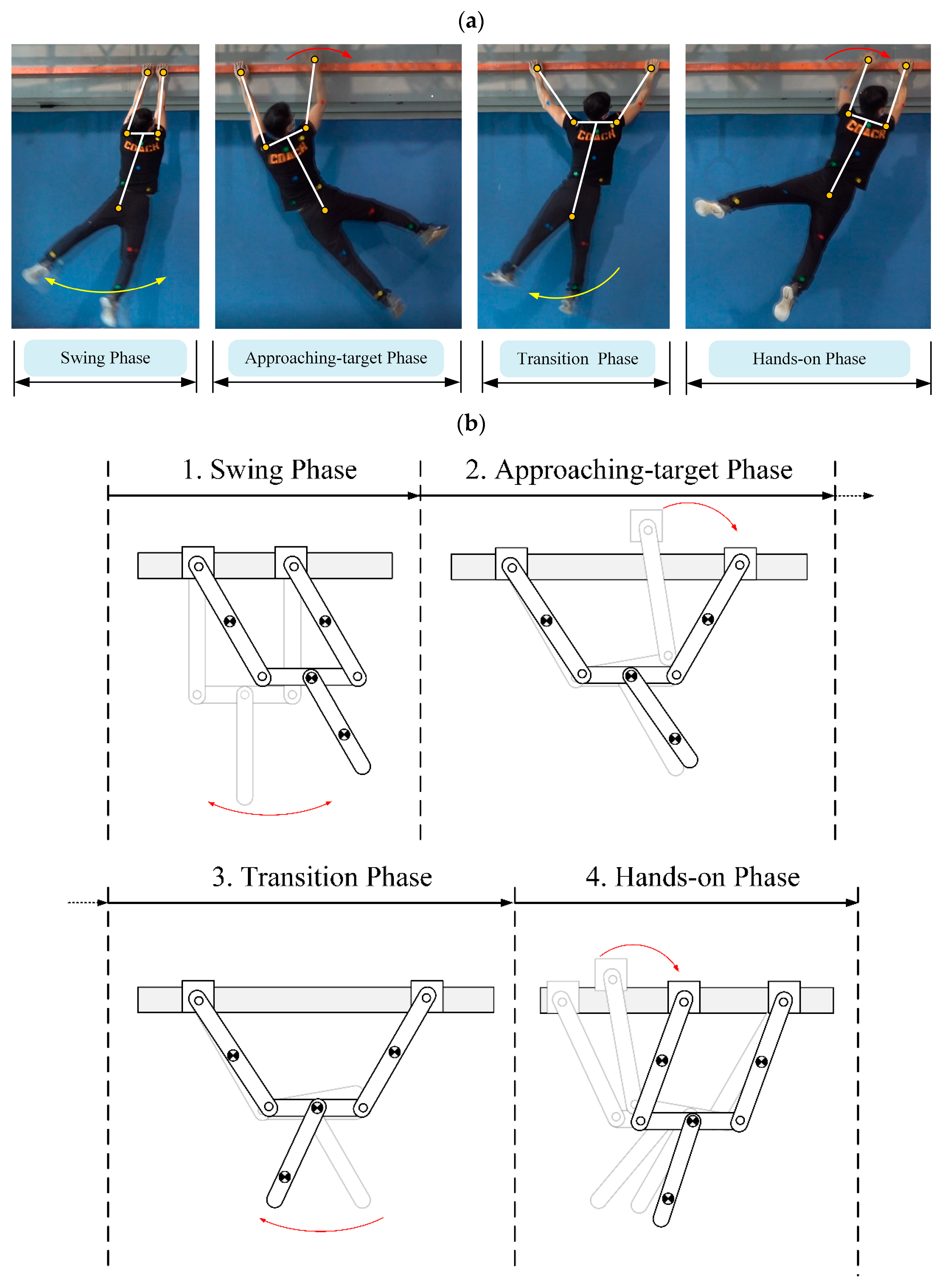
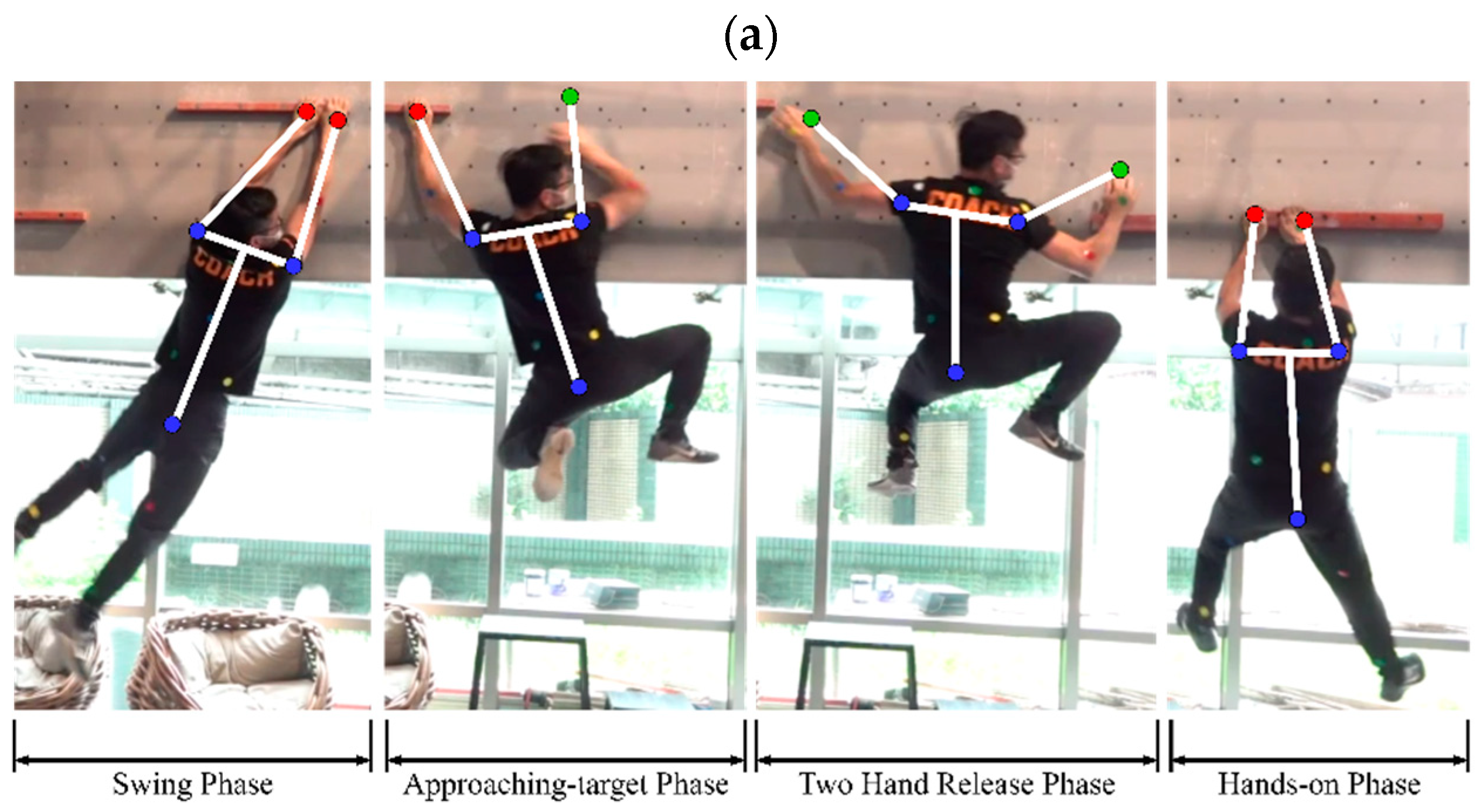
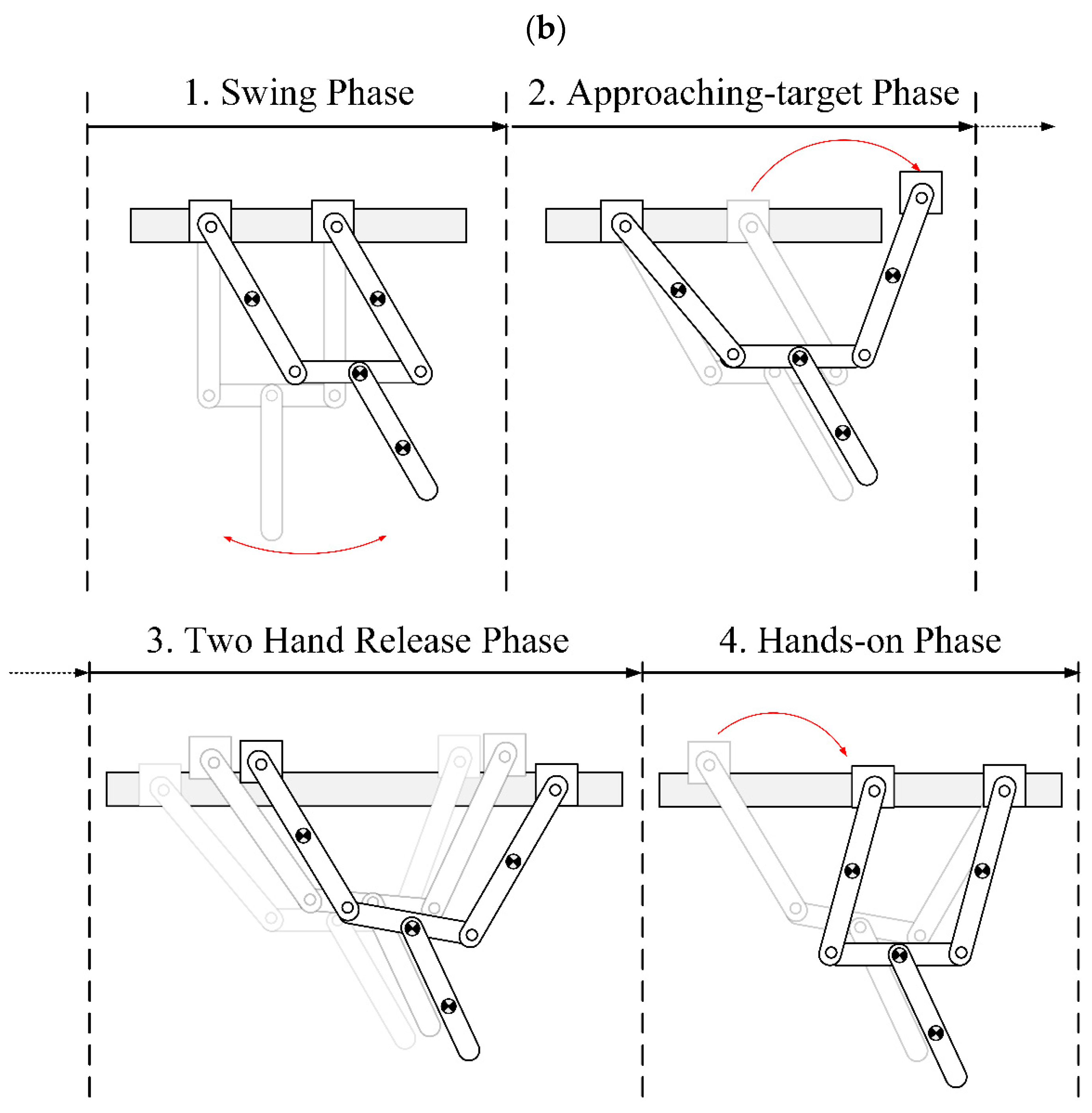
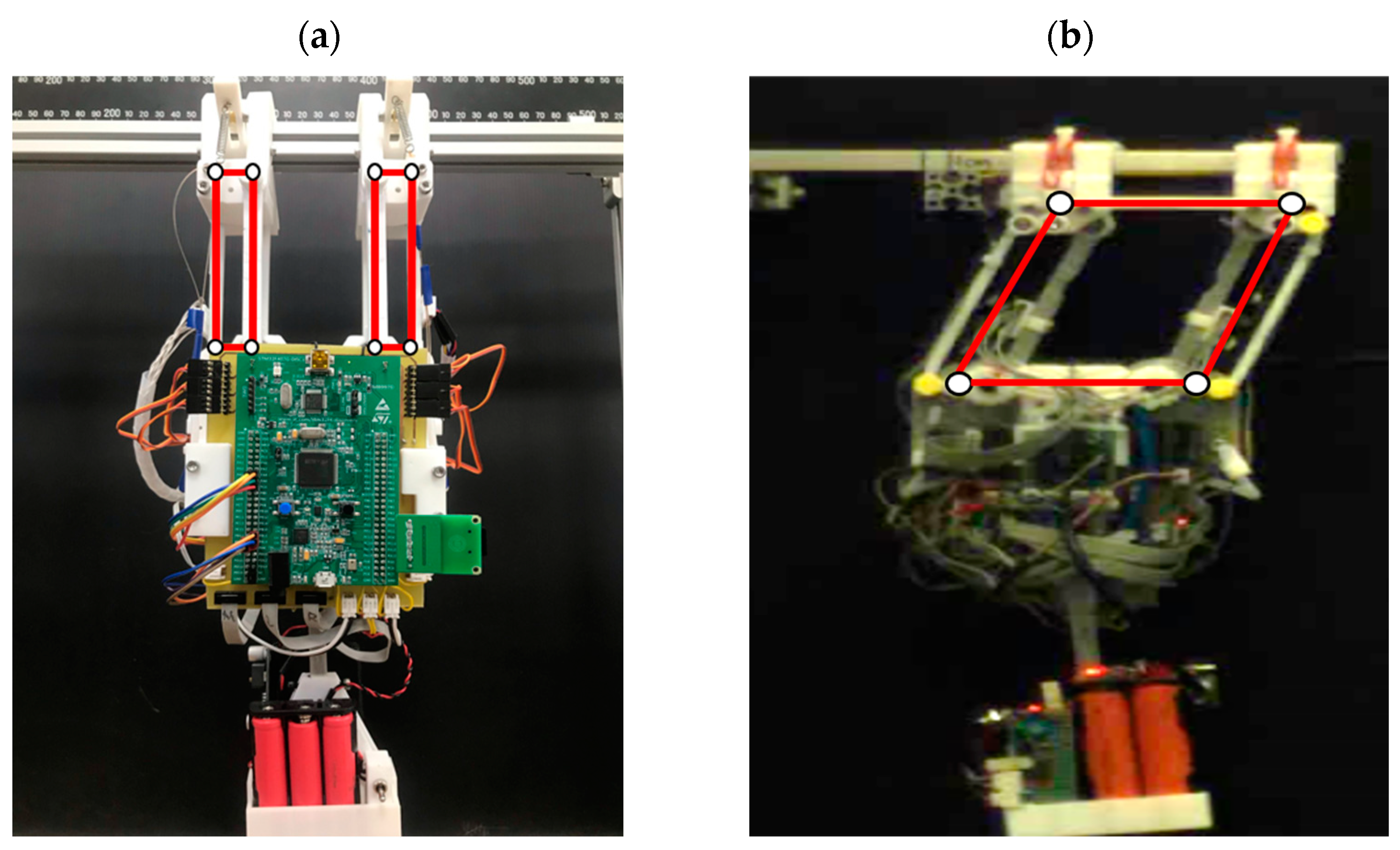
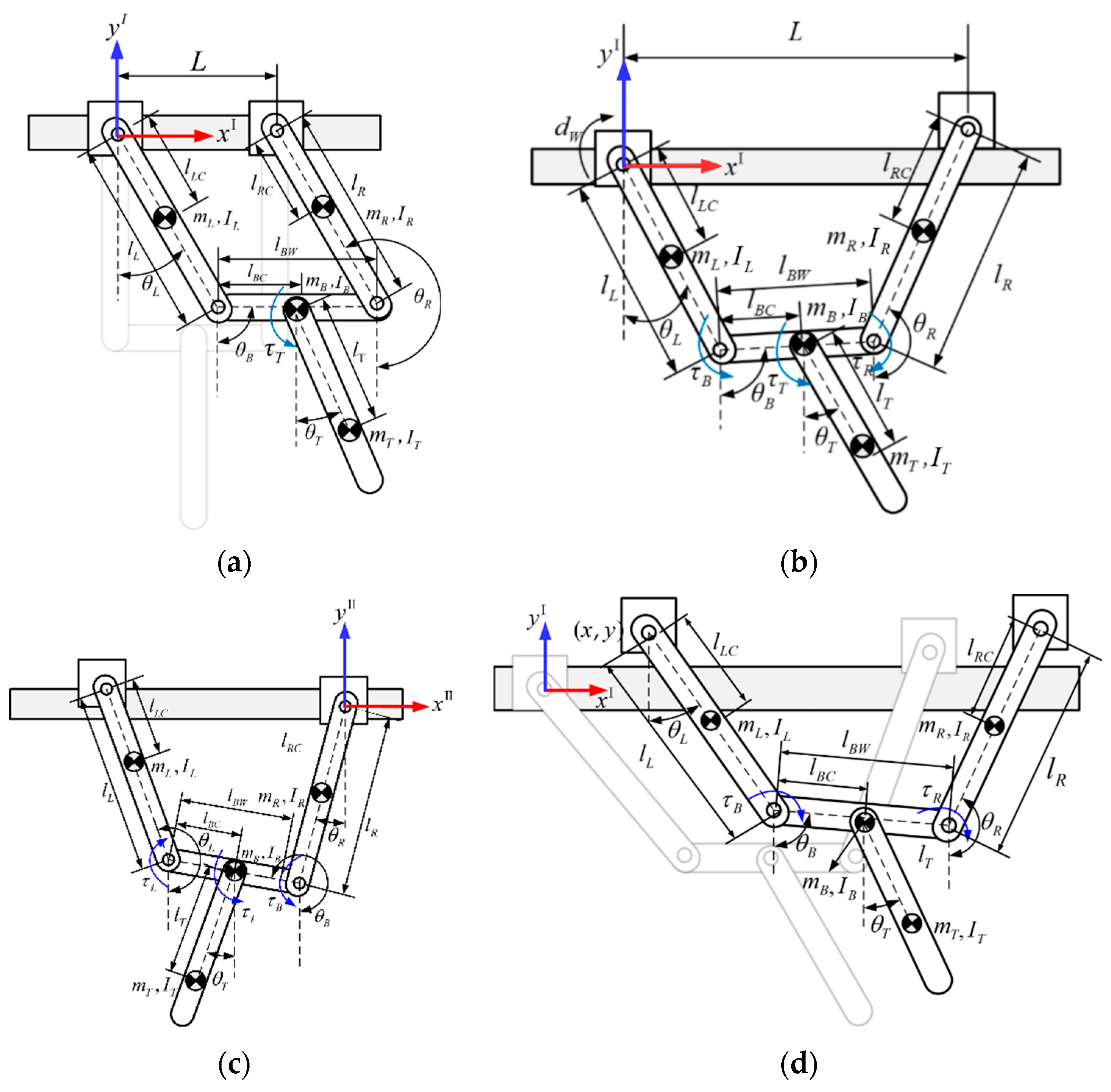
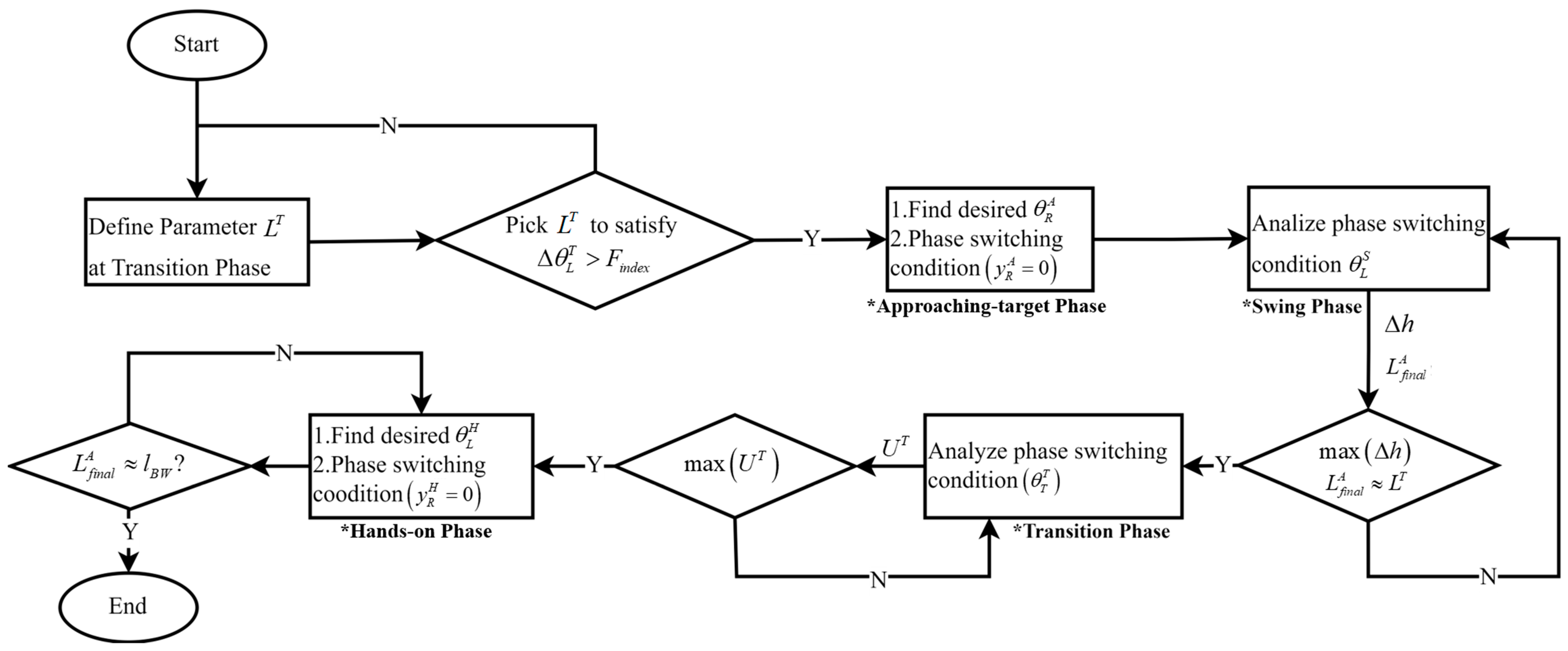
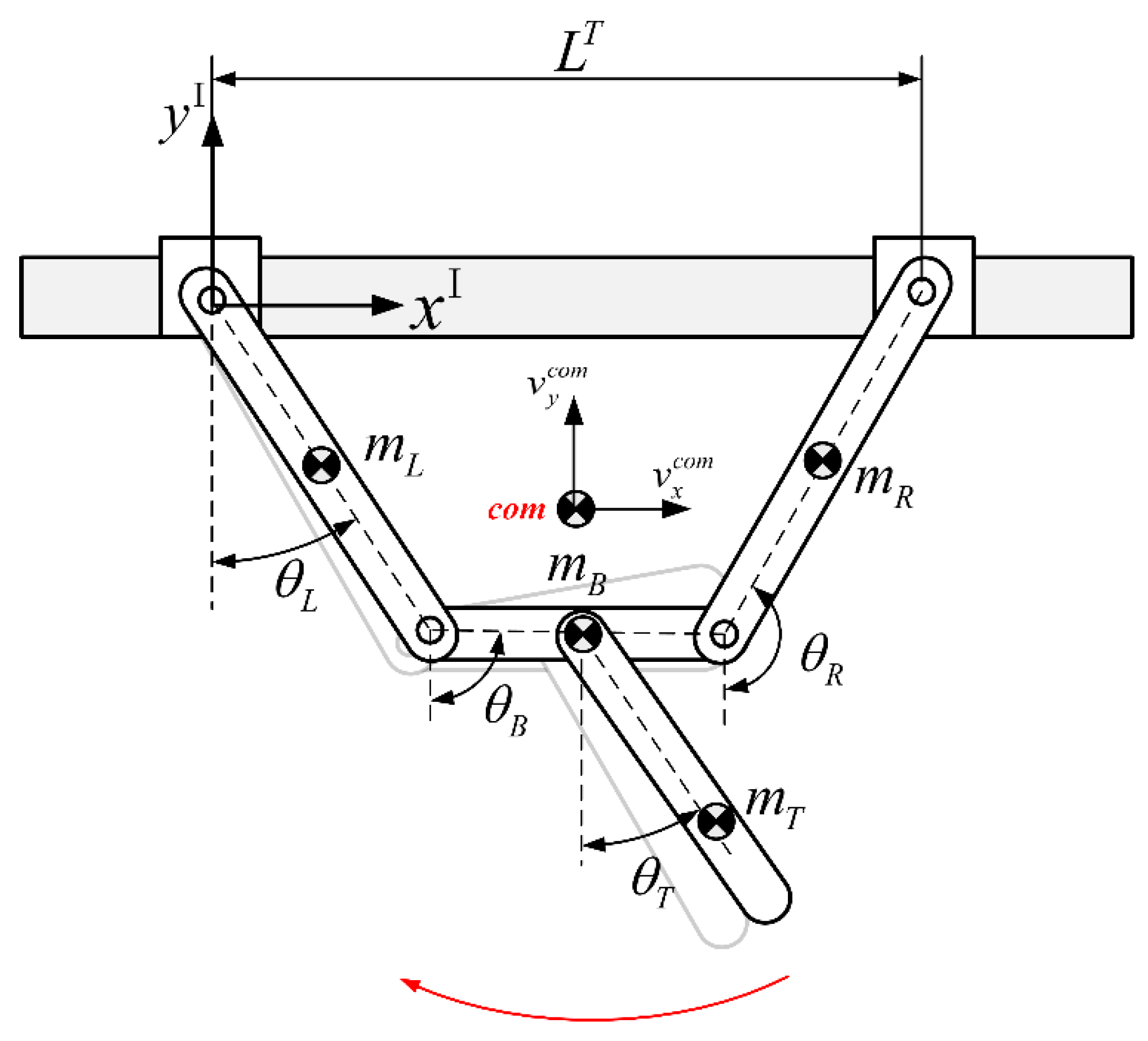
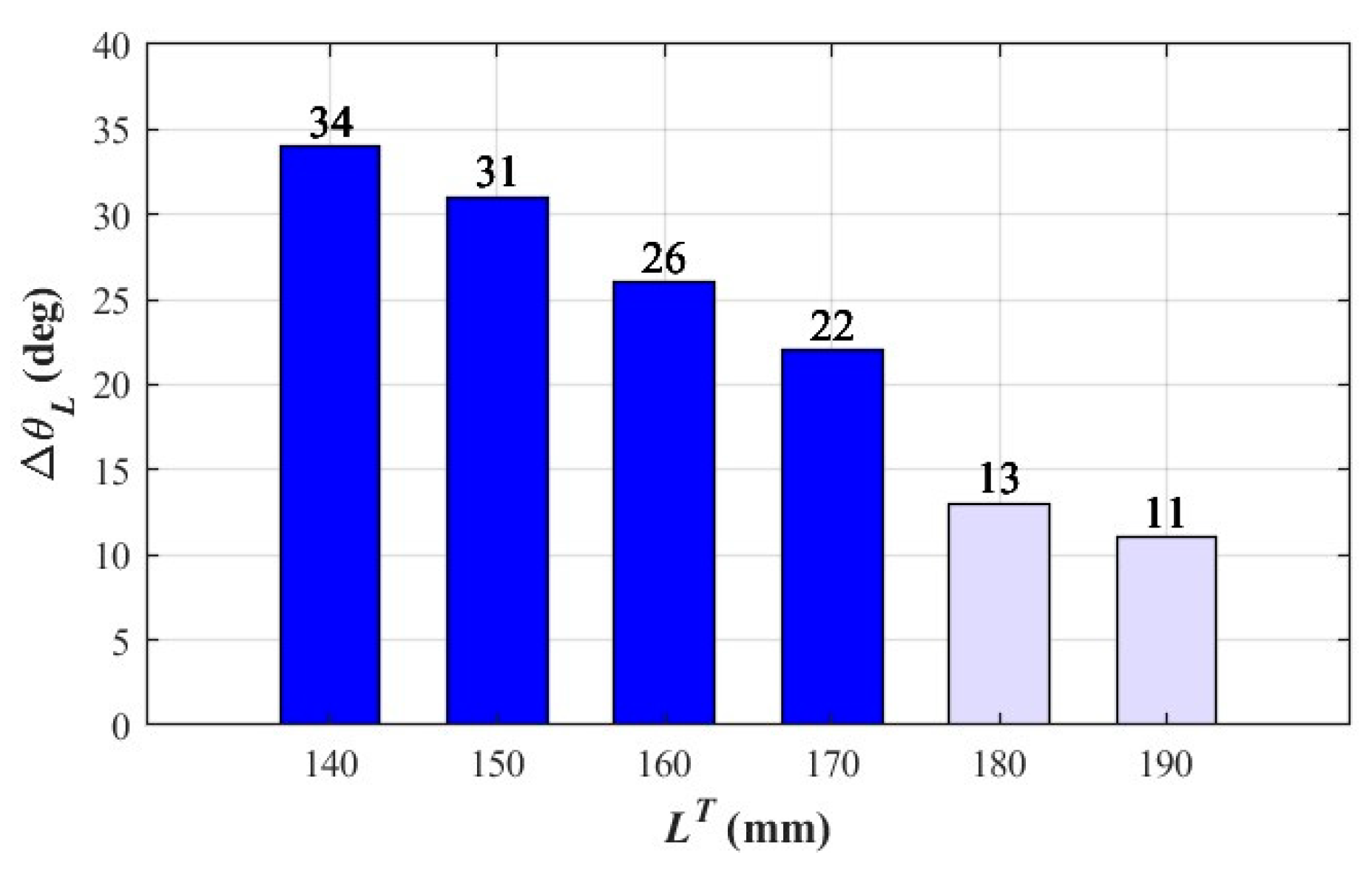
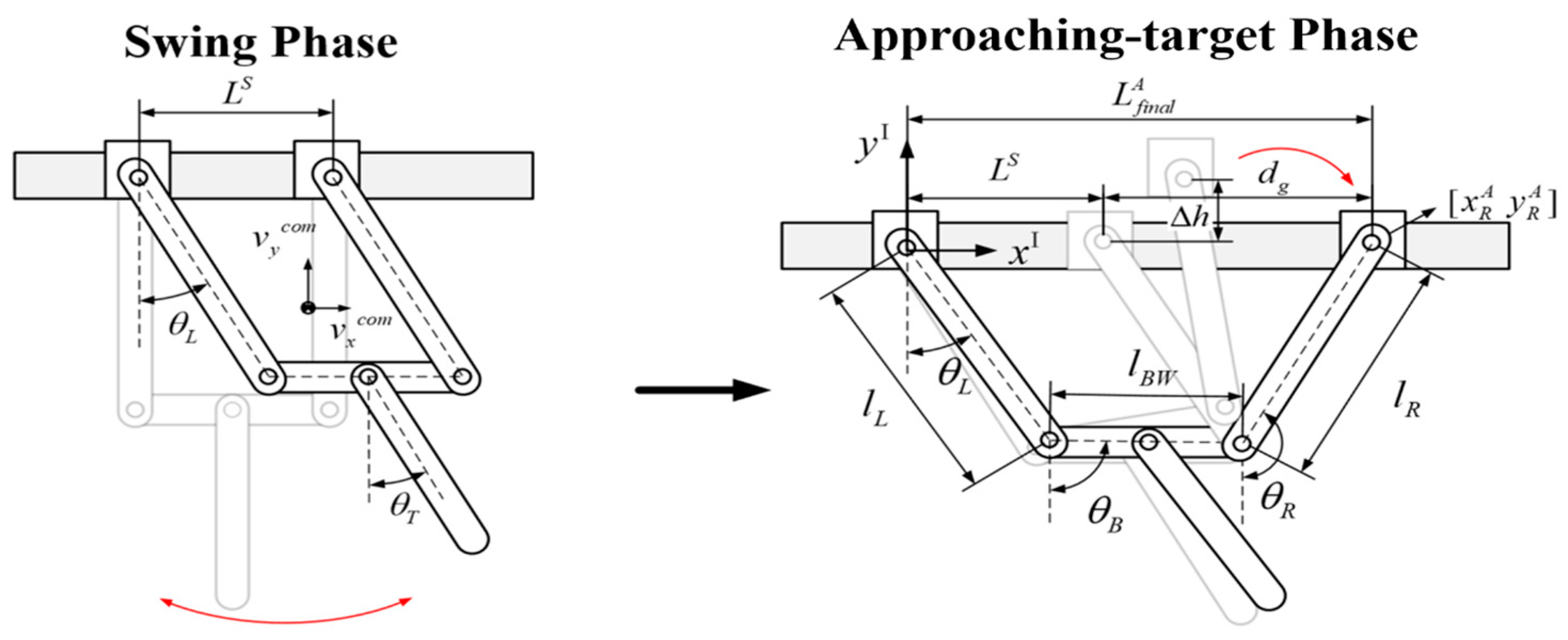
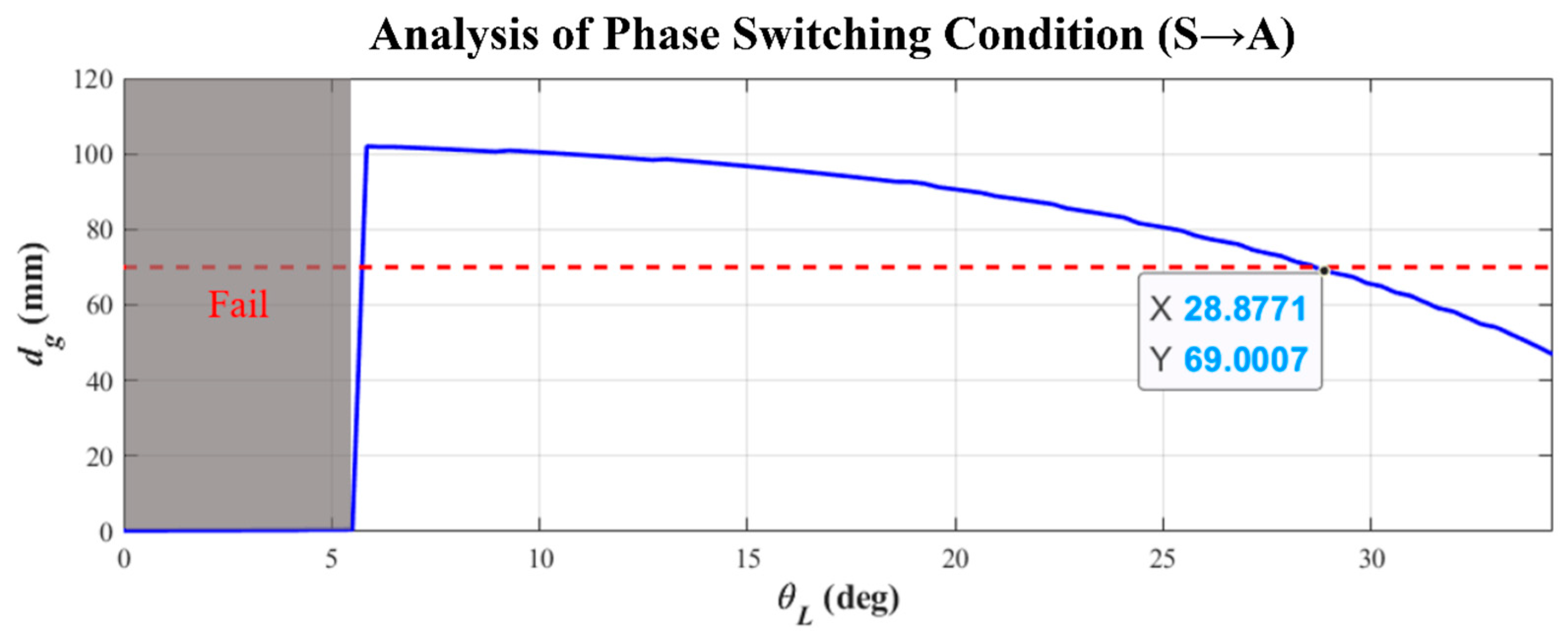
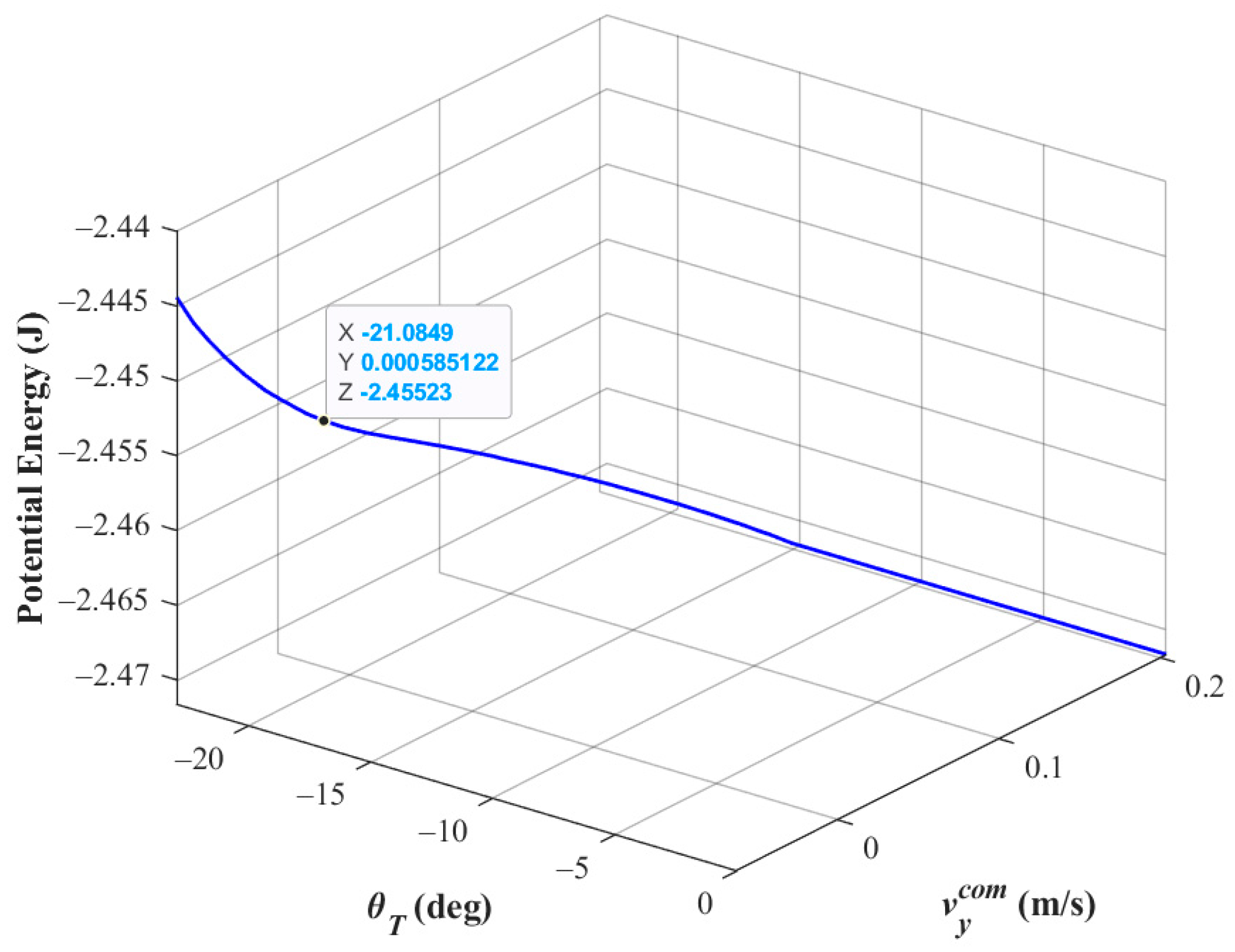
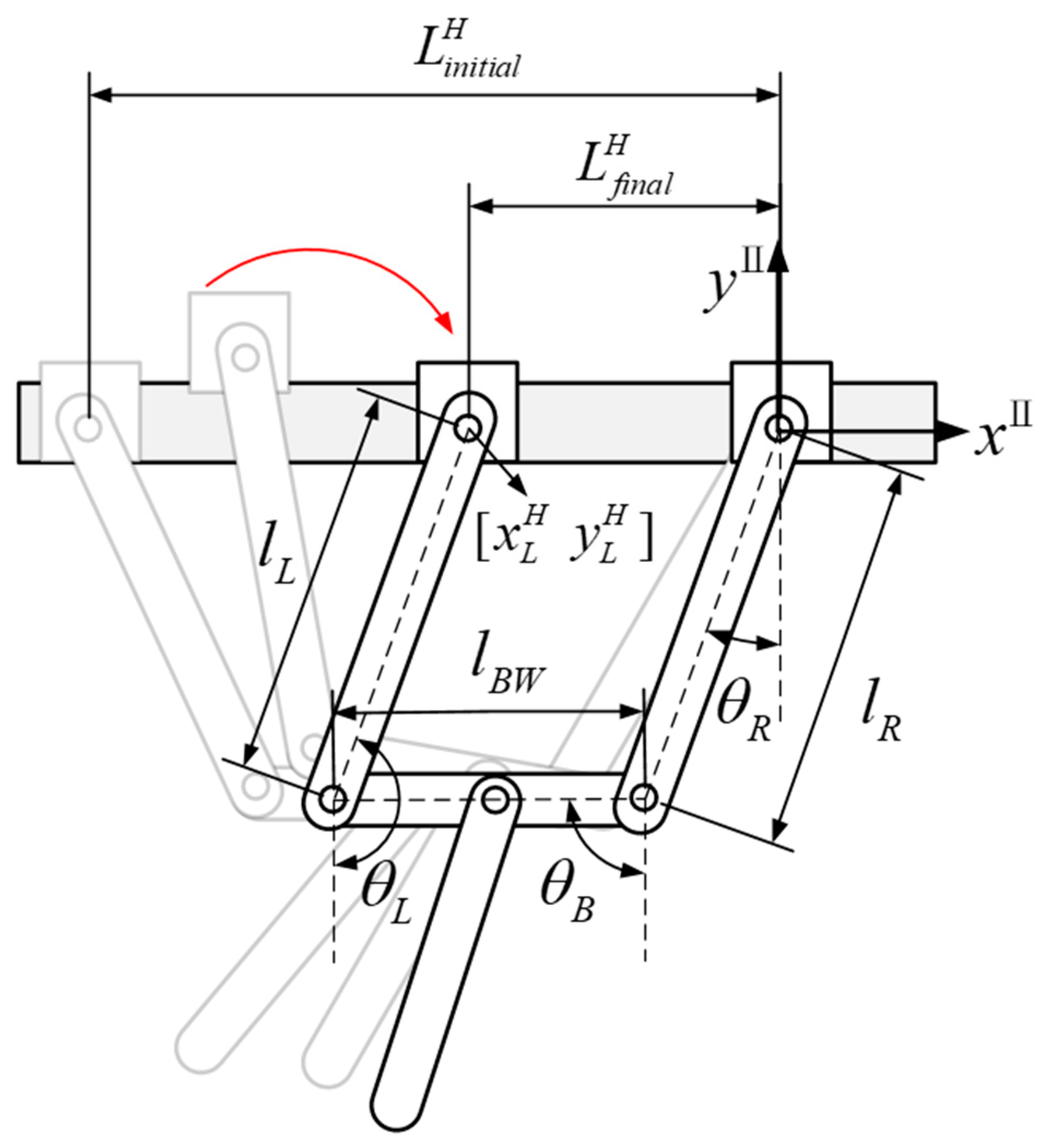

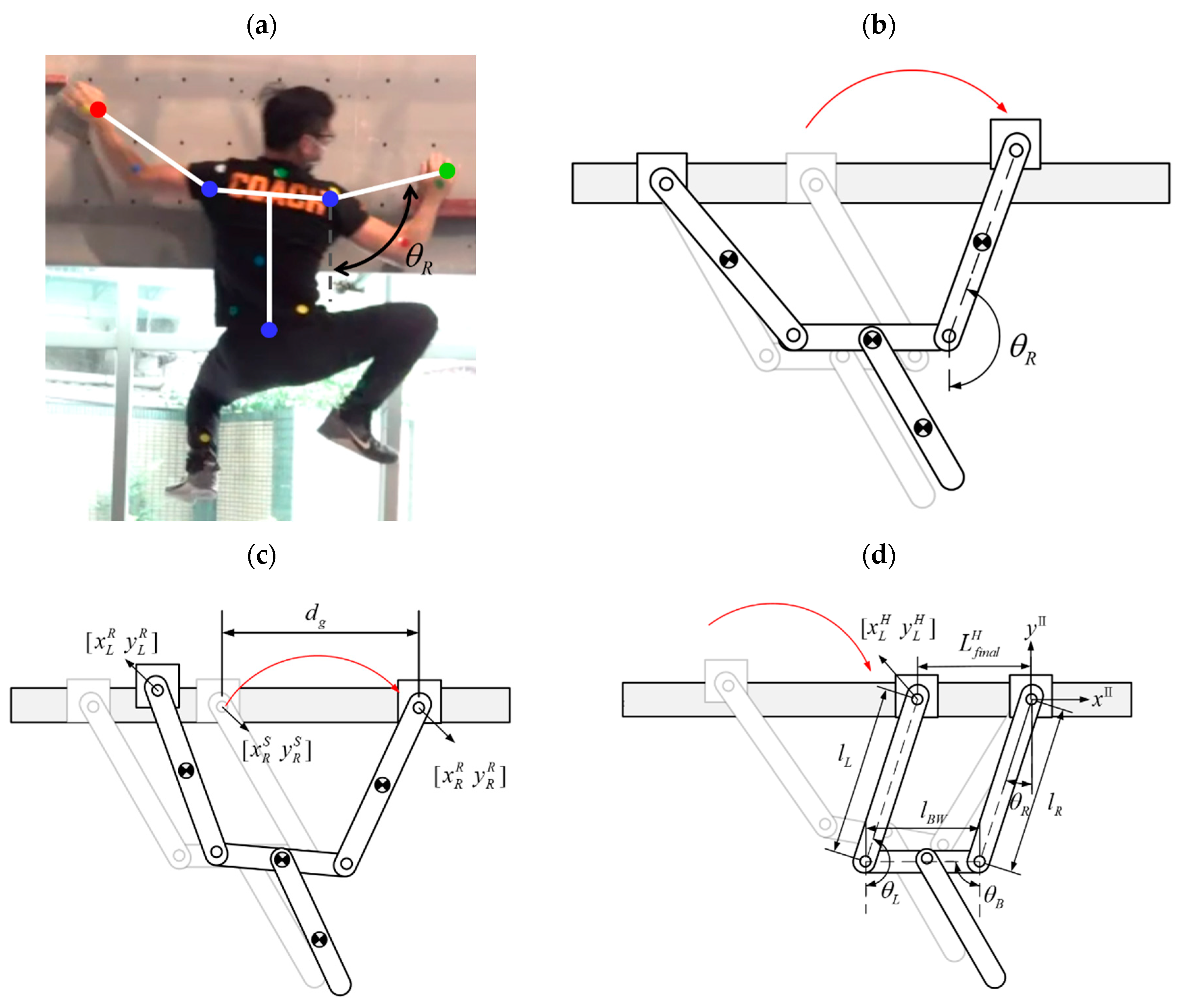
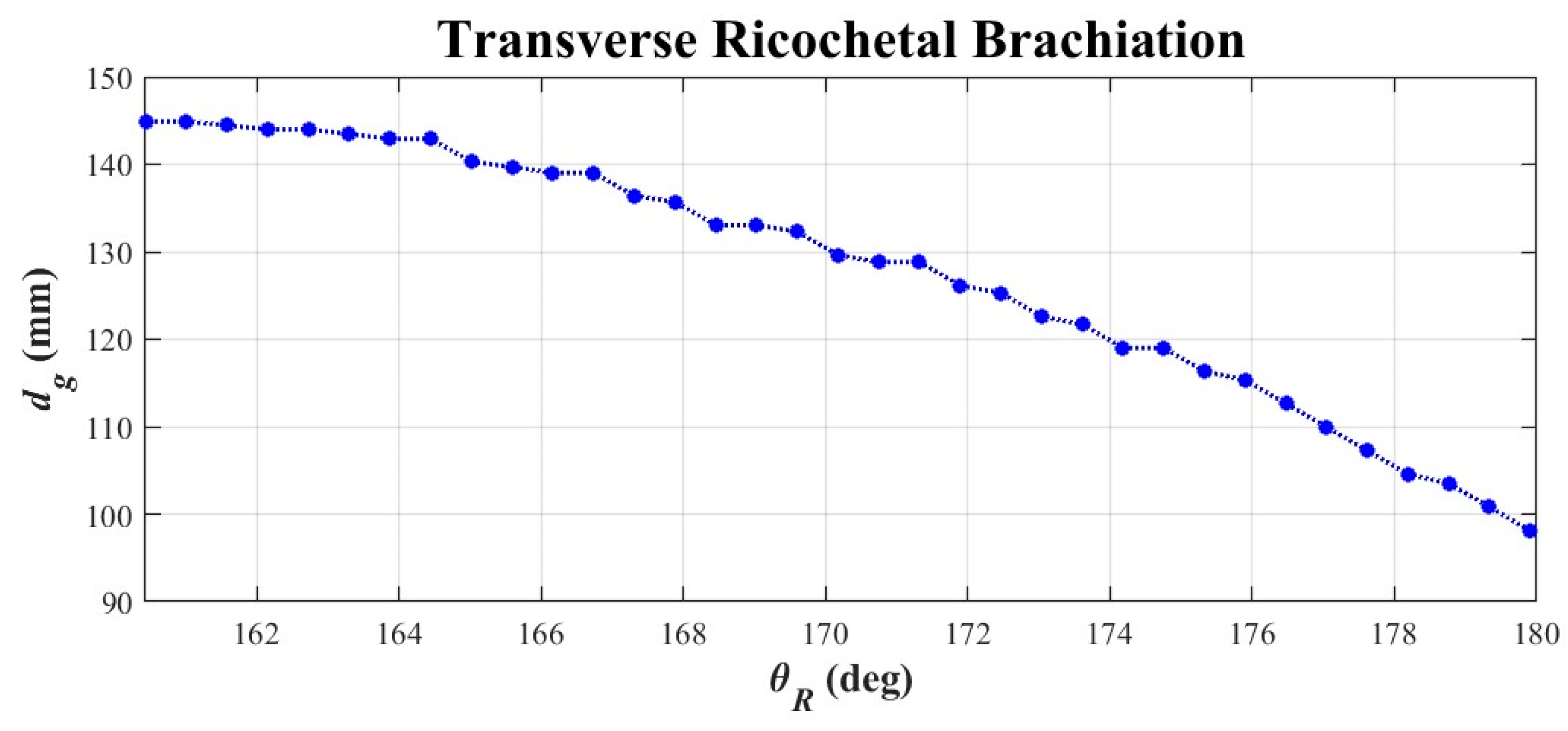
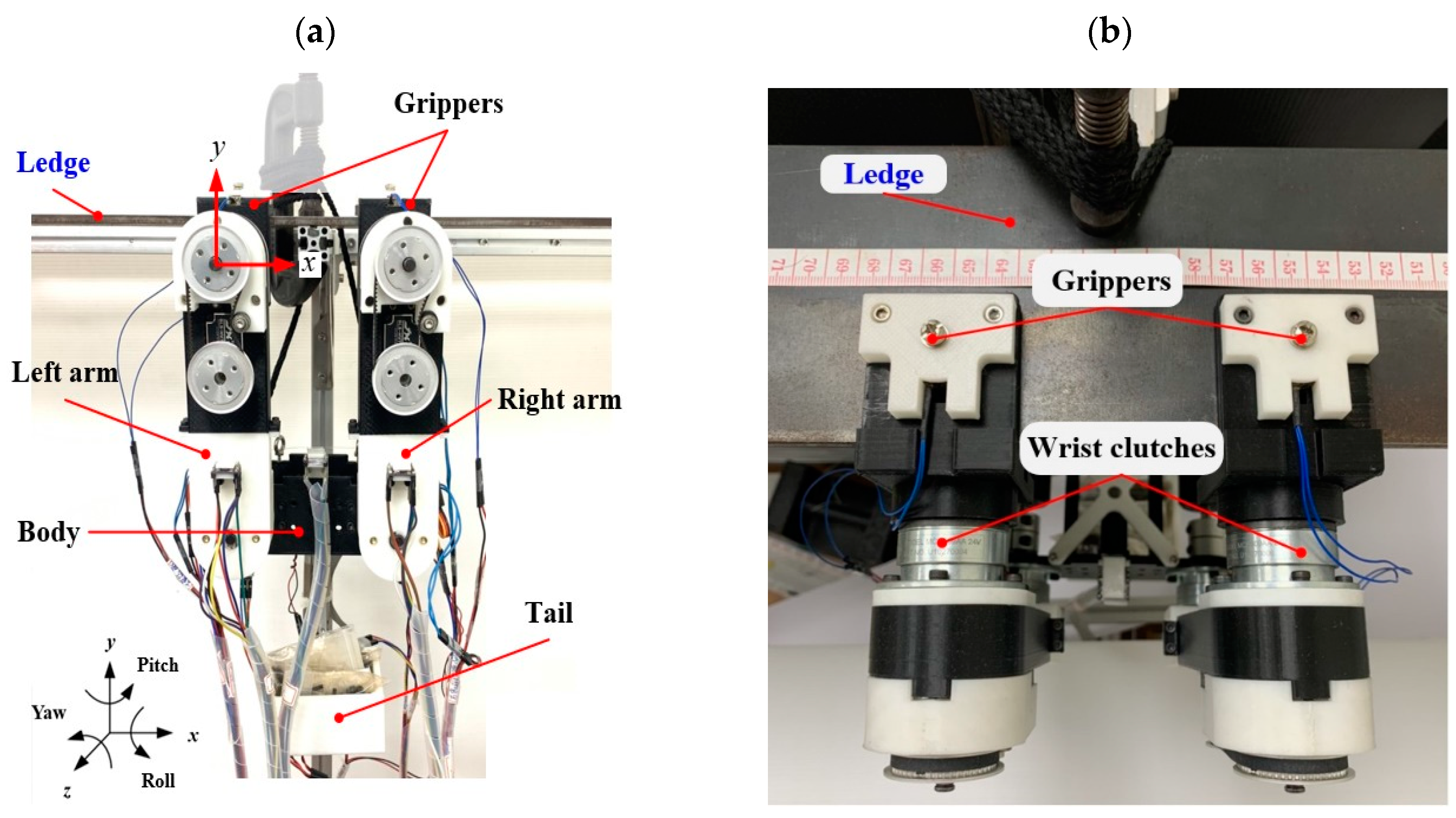

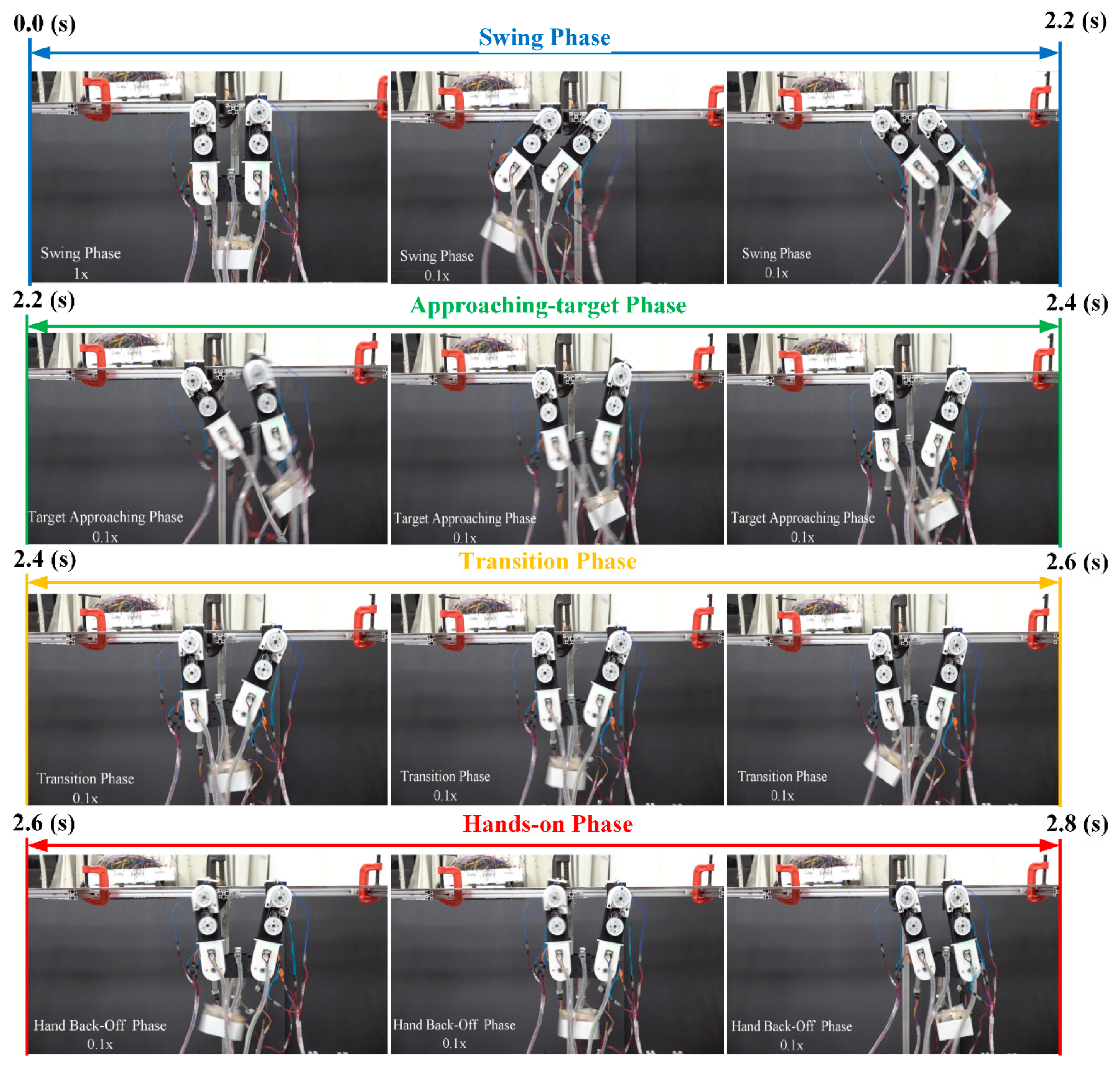
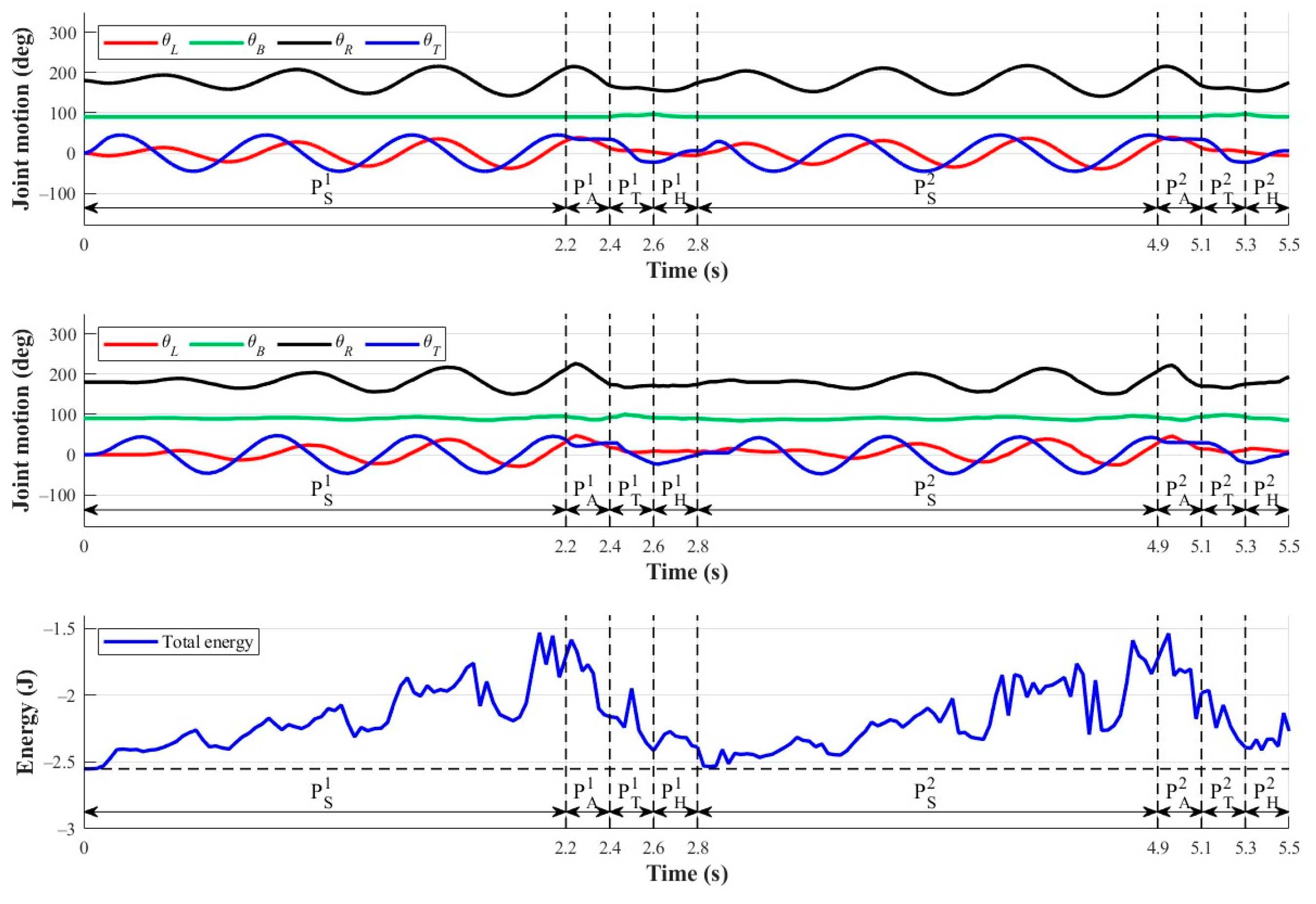
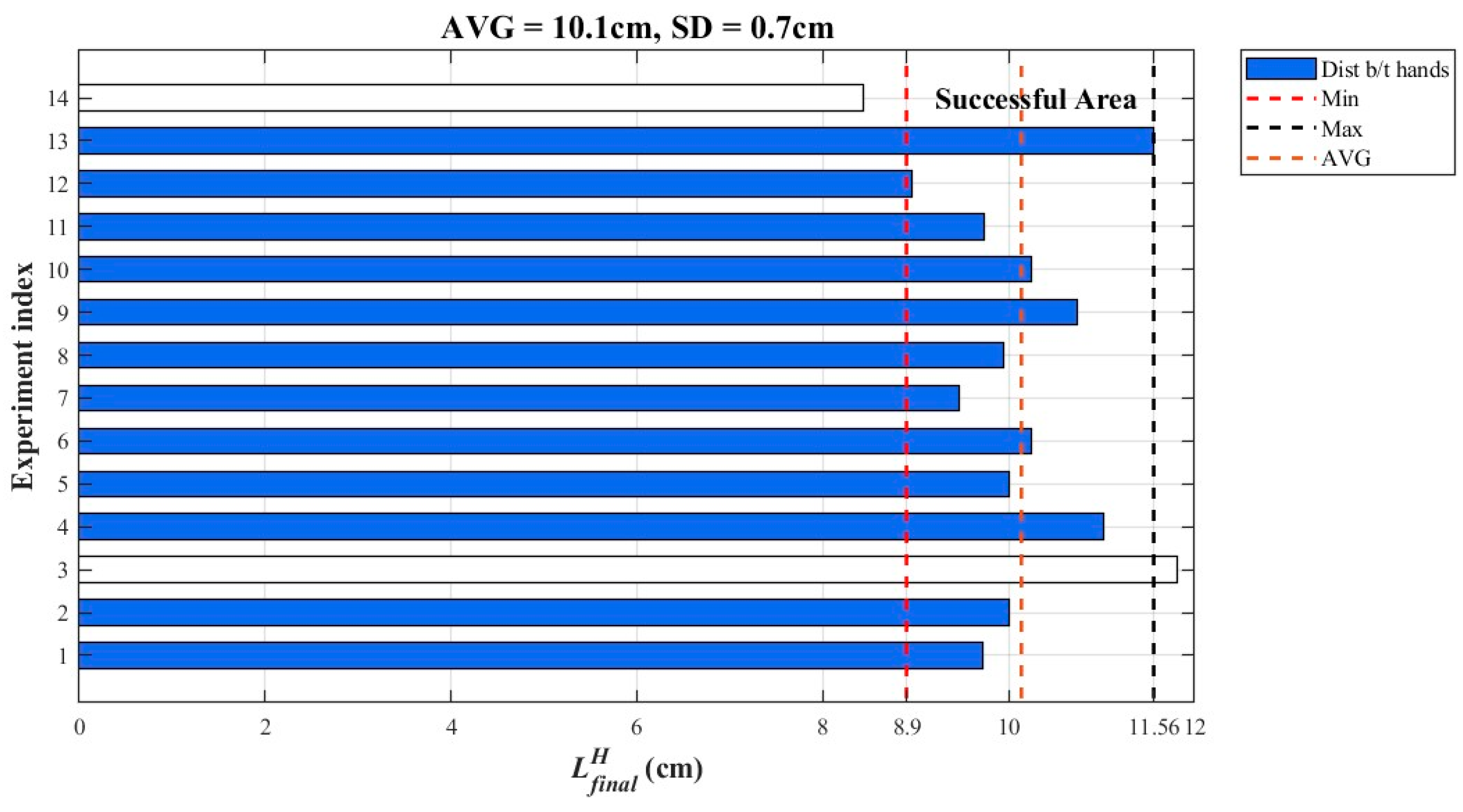
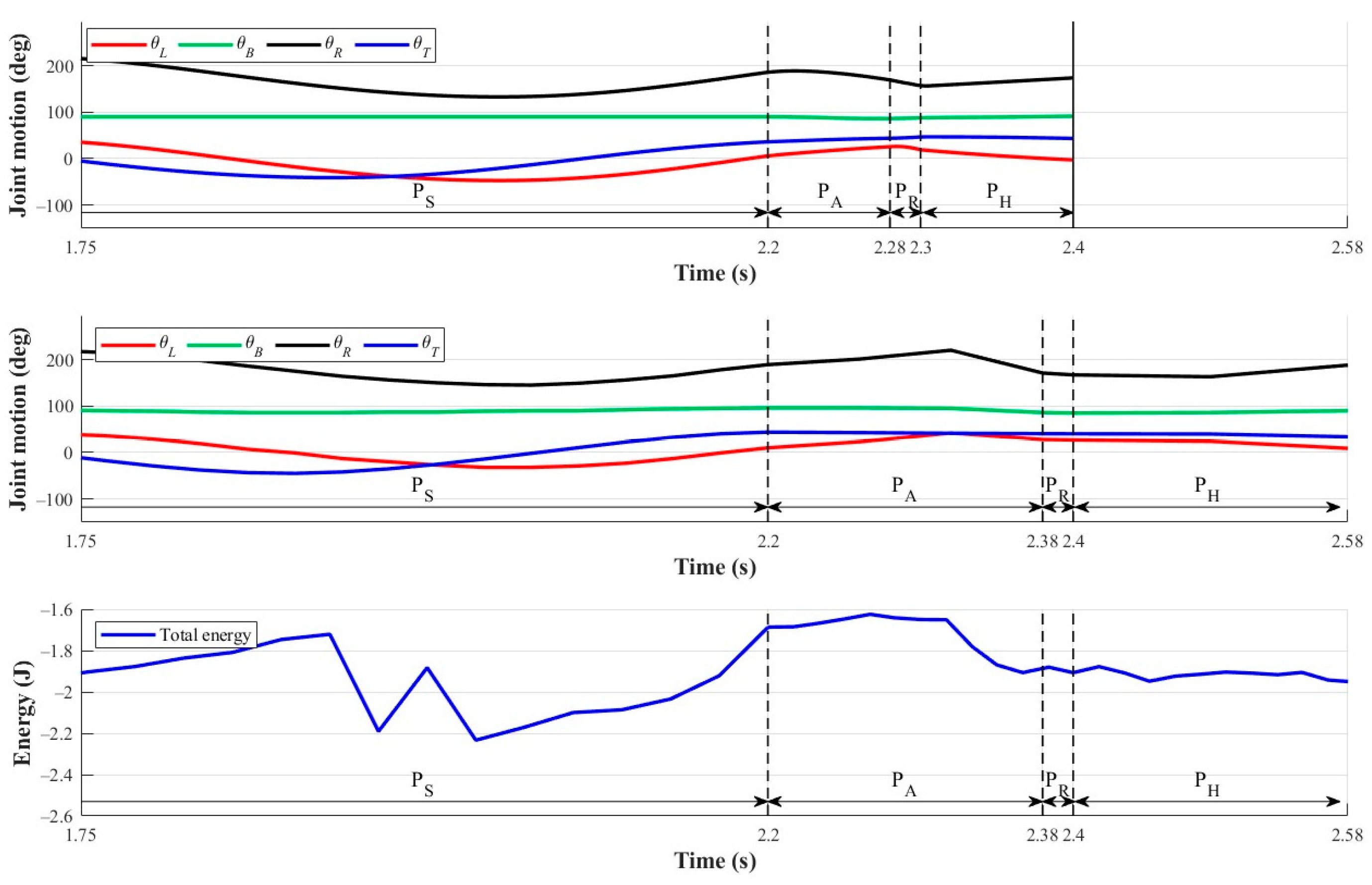

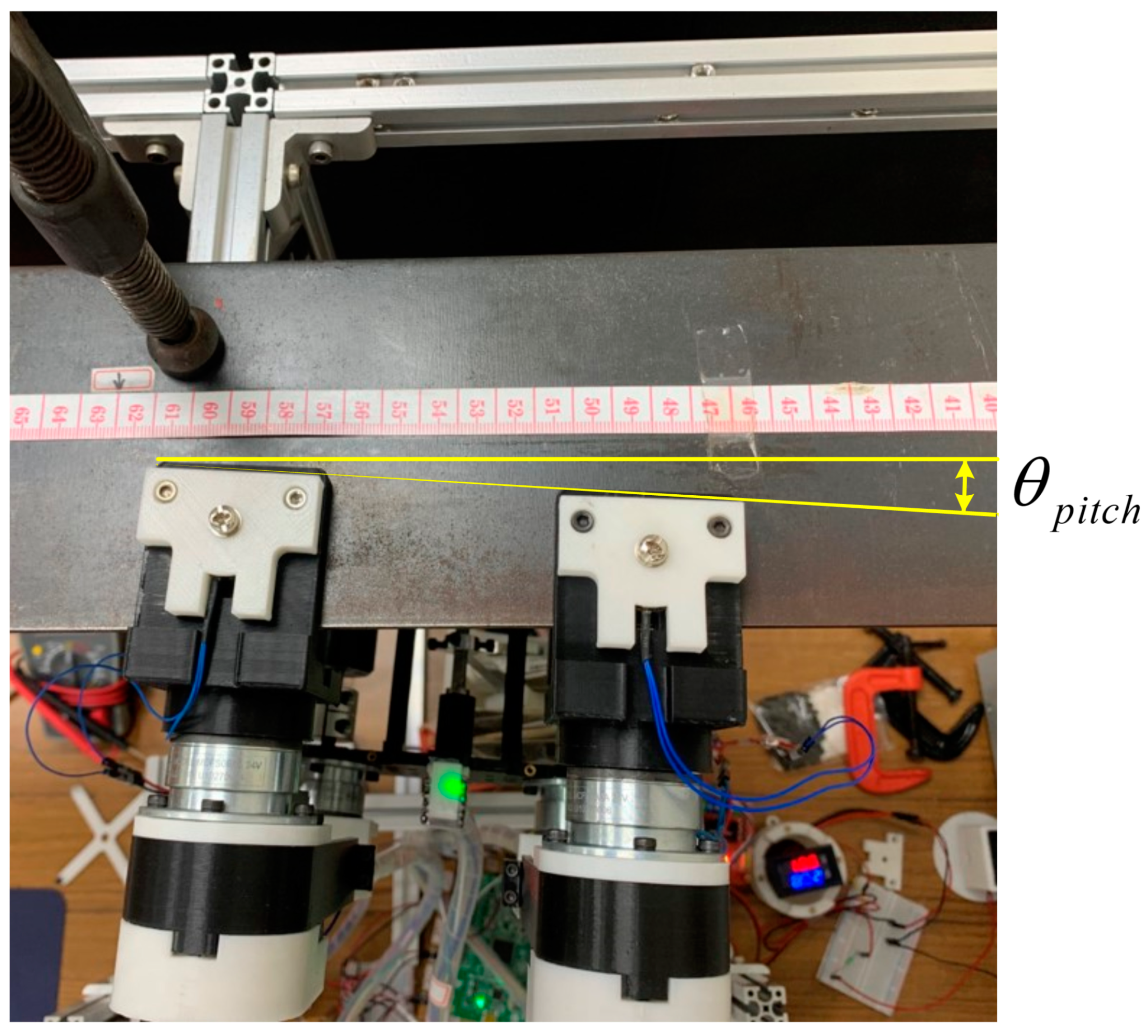
| Current Study | Transverse Ledge Ricochetal Brachiation Robot [1] (Lin and Yang, 2020) | Transverse Ledge Climbing Robot [10] (Lin and Hu, 2022) | Transverse Ledge Brachiation Robot [2] (Lin and Tien, 2022) | |
|---|---|---|---|---|
| Number of robot link | 4 | 4 | 5 | 4 |
| Robot configuration | Arm-body-tail | Arm-body-tail | Arm-body | Arm-body-tail |
| System classification | Arm-body-tail | Arm-body-tail | Arm-body | Arm-body-tail |
| Multi-locomotion | Yes (TLB/TLRB) | No (TLRB) | No (TLC) | No (TLB) |
| Application scenario | Horizontal brachiation (continuous/ gapped ledges) | Horizontal brachiation (continuous/gapped ledges) | Horizontal climbing (continuous/sloped ledges) | Horizontal and non-level horizontal brachiation (ledges at different elevations) |
| Continuous brachiation (via swing) | Yes | No | N/A | No |
| Lower limbs | Yes | Yes | No | Yes |
| Symbol | Physical Meaning | Symbol | Physical Meaning |
|---|---|---|---|
| Center of mass of left arm | Distance between right wrist joint and center of mass of right arm | ||
| Center of mass of right arm | Distance between left shoulder joint and center of mass of body | ||
| Center of mass of body | Distance between left wrist joint and center of mass of left arm | ||
| Center of mass of tail | Tail length | ||
| Moment of inertia of left arm | Body width | ||
| Moment of inertia of right arm | Distance between two grippers | ||
| Moment of inertia of body | Joint angle of left arm | ||
| Moment of inertia of tail | Joint angle of right arm | ||
| Length of left arm | Body joint angle | ||
| Length of right arm | Tail joint angle |
| Simulation | Experiment | |
|---|---|---|
| Grabbing distance at phase PH (mm) | 69 | 63 |
| Time to finish a locomotion cycle (s) | 2.8 | 2.8 |
| Movement speed (mm/s) | 24.6 | 22.5 |
| Transverse Ledge Brachiation | Transverse Ledge Ricochetal Brachiation | |
|---|---|---|
| Grabbing distance (mm) | 63 | 102 |
| Time (s) | 2.8 | 2.58 |
| Movement speed (mm/s) | 22.5 | 39.5 |
| Robot weight (kg) | 1.76 | 1.76 |
| Actuator energy (J) | 6.15 | 8.02 |
| COT (J·kg−1·m−2·s2) | 5.65 | 4.56 |
Disclaimer/Publisher’s Note: The statements, opinions and data contained in all publications are solely those of the individual author(s) and contributor(s) and not of MDPI and/or the editor(s). MDPI and/or the editor(s) disclaim responsibility for any injury to people or property resulting from any ideas, methods, instructions or products referred to in the content. |
© 2023 by the authors. Licensee MDPI, Basel, Switzerland. This article is an open access article distributed under the terms and conditions of the Creative Commons Attribution (CC BY) license (https://creativecommons.org/licenses/by/4.0/).
Share and Cite
Lin, C.-Y.; Lee, J.-M. Multi-Locomotion Design and Implementation of Transverse Ledge Brachiation Robot Inspired by Sport Climbing. Biomimetics 2023, 8, 204. https://doi.org/10.3390/biomimetics8020204
Lin C-Y, Lee J-M. Multi-Locomotion Design and Implementation of Transverse Ledge Brachiation Robot Inspired by Sport Climbing. Biomimetics. 2023; 8(2):204. https://doi.org/10.3390/biomimetics8020204
Chicago/Turabian StyleLin, Chi-Ying, and Jhe-Ming Lee. 2023. "Multi-Locomotion Design and Implementation of Transverse Ledge Brachiation Robot Inspired by Sport Climbing" Biomimetics 8, no. 2: 204. https://doi.org/10.3390/biomimetics8020204








